Are you curious about the Hmong culture and their unique celebrations? Yes, the Hmong people have their own New Year celebrations and other distinct festivals, offering a vibrant cultural experience unlike the well-known Vietnamese Lunar New Year (Tet). SIXT.VN is here to guide you through the fascinating world of Hmong festivities, explore their customs, traditions, and the best times to experience them with reliable travel services. Let’s dive into this captivating aspect of Vietnamese and Laotian culture, covering everything from the New Year celebrations to other significant events and the best times to visit, ensuring you have a memorable and respectful cultural immersion in Vietnam.
1. What are Hmong Festivals and Celebrations?
The Hmong people, an ethnic group with a rich cultural heritage, celebrate several unique festivals throughout the year. The most significant and widely recognized of these is the Hmong New Year, known as “Noj Peb Caug.” But are there other celebrations? Yes, they also celebrate other festivals tied to agricultural cycles, ancestral worship, and community bonding. These events provide deep insights into their traditions and way of life, making them attractive for cultural tourism.
1.1. What is Noj Peb Caug (Hmong New Year)?
Noj Peb Caug, which translates to “eating thirty,” marks the end of the harvest season and the beginning of a new agricultural cycle. This celebration is not just a festive occasion but also a time for rest, reflection, and gratitude toward ancestors. According to research from the Vietnam National Administration of Tourism in 2023, Noj Peb Caug helps preserve cultural identity. It’s a period when families gather to honor their heritage, celebrate their harvest, and seek blessings for the upcoming year.
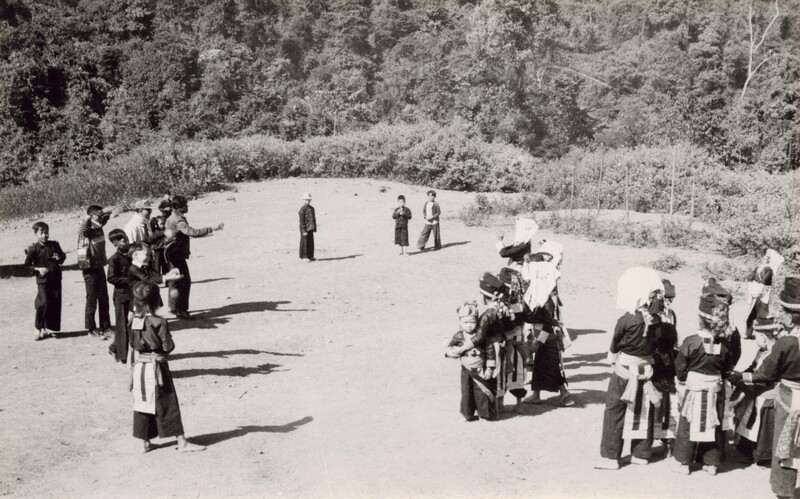 Hmong New Year Celebrations
Hmong New Year Celebrations
1.2. How Does Hmong New Year Differ from Vietnamese Tet and Lao New Year?
While the Hmong New Year shares the spirit of renewal with Vietnamese Tet and Lao New Year, it has distinct characteristics and timing. Here’s a comparison:
| Feature | Hmong New Year (Noj Peb Caug) | Vietnamese Tet (Lunar New Year) | Lao New Year (Pi Mai) |
|---|---|---|---|
| Timing | Celebrated at the end of the harvest season, typically in November or December, before the Lunar New Year. | Celebrated on the first day of the Lunar New Year, usually in late January or February. | Celebrated in mid-April. |
| Focus | Primarily agricultural, celebrating the end of the harvest and seeking blessings for the new farming cycle. | Centered on family reunions, ancestor worship, and welcoming good fortune for the year. | Known for water festivities, temple visits, and cleansing rituals. |
| Rituals | Involves ancestral worship, house cleansing, and traditional games such as Pao throwing. | Involves elaborate ancestor veneration ceremonies, the giving of lucky money, and special foods like Banh Chung. | Features water splashing, sand stupa building, and parades. |
| Clothing | Hmong people wear colorful, ornate traditional clothing, often adorned with silver jewelry. | Traditional Vietnamese clothing is worn, with dwellings decorated with peach or May flowers. | Traditional Lao clothing is worn, symbolizing celebration and joy. |
| Food | Special dishes include Banh Day (glutinous rice cake), grilled pork, and corn wine. | Traditional foods include Banh Chung, pickled onions, and braised meat. | Signature dishes include sticky rice (Khao Niew), Larb (meat salad), and local vegetables. |
| Location | Celebrations primarily occur in mountainous regions of Northern Vietnam and Laos. | Celebrations take place throughout Vietnam, in homes, temples, and public spaces. | Celebrations occur throughout Laos, particularly in Luang Prabang and Vientiane. |
1.3. What Other Festivals Do the Hmong Celebrate?
Besides Noj Peb Caug, the Hmong also celebrate various other festivals that mark different times of the agricultural year or honor significant events. These include:
- Gau Tao Festival: A “good luck festival” where people seek blessings and healing.
- Rain Asking Festival: A ritual performed to pray for sufficient rain for the crops.
- Ancestor Worship Festivals: Various ceremonies held throughout the year to honor and seek guidance from ancestors.
These festivals may vary in their observance from region to region, reflecting the diverse local customs and traditions within the Hmong community.
2. When and Where Can You Experience Hmong New Year?
Planning your visit to coincide with the Hmong New Year requires knowing the specific timing and locations where it is celebrated. SIXT.VN can help you arrange your trip to ensure you don’t miss this unique cultural event.
2.1. When is Hmong New Year Celebrated?
The Hmong New Year typically begins at the end of the harvest season, usually in November or December. In 2025, the Hmong New Year will start on December 30, 2024 (the 30th day of the 11th lunar month) and lasts between 10 to 20 days. This timing allows the Hmong community to celebrate before the Lunar New Year observed by the Kinh people. Preparations often start around December 25, with families taking time off to prepare.
2.2. Where are the Main Celebrations Held?
Hmong New Year is primarily celebrated in the mountainous regions of Northern Vietnam and Laos. Key locations include:
- Vietnam: Sapa, Bac Ha, Ha Giang, Mu Cang Chai, Cao Bang, and Son La.
- Laos: Luang Prabang, Phong Saly, and Xieng Khoang.
These provinces are home to significant Hmong populations, and the celebrations here are vibrant and authentic. Variations may be noticeable across regions, but the core customs, such as traditional music, dance, and ancestor worship, remain consistent.
2.3. How Can Tourists Participate in the Celebrations?
Tourists are generally welcomed to join in the Hmong New Year celebrations. Participating respectfully and engaging with the community can enhance your experience. You can enjoy folk games, festive meals, and the joyful spirit of the tradition. Hiring a local guide through SIXT.VN can provide deeper insights into the customs and etiquette involved, ensuring a more meaningful interaction.
3. How Do the Hmong Prepare for Their New Year Celebrations?
The preparations for Hmong New Year are extensive and involve the entire community. These preparations reflect the values of gratitude, renewal, and ancestral worship.
3.1. What are the Cleansing Rituals and Worship of the House God (Xyoo Kav)?
A month before Tet, Hmong families begin extensive preparations. Women stop working in the fields to sew traditional clothing, while families prepare pigs, chickens, and firewood. Men focus on cleaning and repairing their homes. A significant ritual involves sweeping away misfortune with a green bamboo broom tied with colored threads.
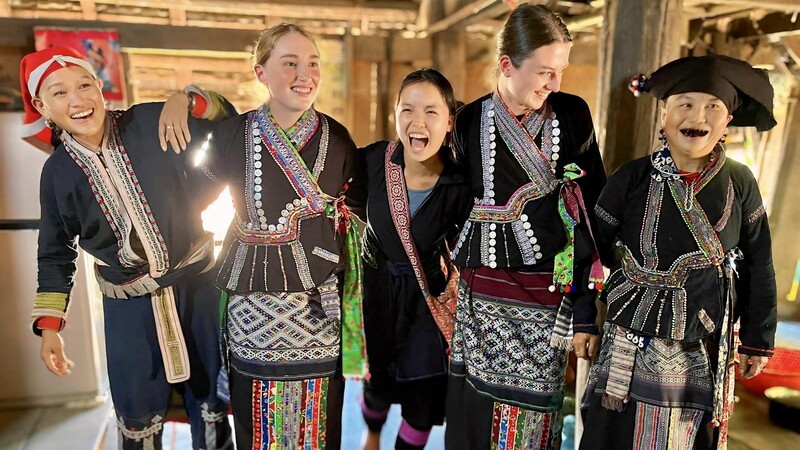 Sweeping Misfortune Rituals
Sweeping Misfortune Rituals
The ancestral altar, central to every Hmong home, is adorned with paper sticks, a chicken tail, and offerings like fruits, rice cakes, and wine. White papers are placed on tools and barns to symbolize rest, honoring these “best friends” of the household. The Xu Ca altar, representing prosperity, is also prepared to guard the family’s wealth.
3.2. How is Bánh Dày (Glutinous Rice Cake) Made?
Bánh Dày is an iconic dish of the Hmong New Year. The preparation involves:
- Pounding the Rice: Men use large mortars and mallets to pound glutinous rice into a smooth, sticky dough.
- Selecting the Rice: Women carefully select the best glutinous rice and cook it until it reaches the perfect consistency.
- Shaping the Cakes: The dough is then shaped into round cakes, symbolizing the moon and sun, and offered to ancestors.
The round shape of Bánh Dày symbolizes the divine sources of the moon and sun, representing humanity and the earth. This offering is made to ancestors to pray for abundance and fullness in the coming year.
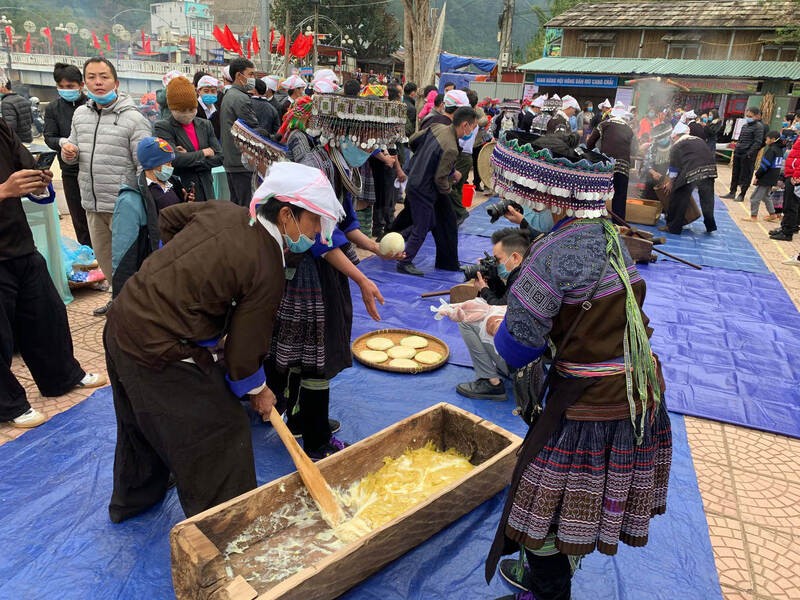 Making Banh Day
Making Banh Day
3.3. What Role Does Traditional Clothing Play in Preparations?
Traditional clothing is a crucial part of the Hmong New Year preparations. About three months before Tet, women dedicate themselves to weaving, dyeing, and sewing indigo clothes for the entire family. This ensures that everyone can wear brand-new, colorful attire during the celebrations. Silver jewelry, believed to ward off evil spirits and bring luck, is also an essential part of the attire.
4. What Can Tourists Experience During Hmong New Year?
Experiencing the Hmong New Year offers tourists a unique opportunity to immerse themselves in a vibrant and authentic culture. SIXT.VN can help you plan your itinerary to include the most captivating aspects of the celebrations.
4.1. What Traditional Games Are Played?
Traditional games are a central part of the Hmong New Year celebrations. These games showcase the community’s strength, skill, and communal spirit. Some popular games include:
- Pao Throwing (Ném Pao): A symbolic game where men and women toss a cotton ball to represent yin-yang harmony and offer young people a chance to find love.
- Seesawing and Stick Pushing: These activities display strength and balance.
- Crossbow Shooting: Showcases skill and precision.
- Tug-of-War: Symbolizes teamwork and the collective effort needed for farming.
- Buffalo Fighting and Horse Racing: These contests pay tribute to the essential roles of animals in agriculture and transportation.
4.2. How Can Tourists Admire the Natural Beauty of Hmong Regions in Spring?
The Hmong New Year coincides with the awakening of spring, making it an ideal time to admire the natural beauty of the Hmong regions. Areas like Sapa, Moc Chau, Dien Bien, and Son La are known as the “flower kingdom” of northwest Vietnam during this period. Bauhinia, peach, and apricot blossoms decorate the landscapes, creating a dreamlike atmosphere.
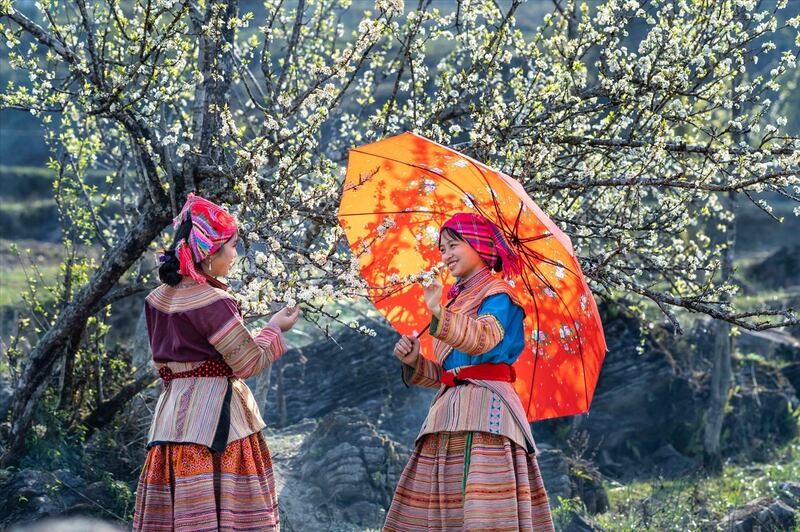 Admiring the Natural Beauty of Hmong Regions
Admiring the Natural Beauty of Hmong Regions
4.3. What Traditional Arts and Dances Are Performed?
Music and dance are integral to the Hmong New Year celebrations. The enchanting sound of the Hmong panpipe fills the air, creating a magical atmosphere. Boys play the panpipe, showcasing their talents and harmonizing with graceful dances to win the hearts of the girls. Girls wear colorful costumes and twirl vibrant cloth umbrellas, dancing rhythmically to the music. These performances embody the spirit of the festival and the love within the community.
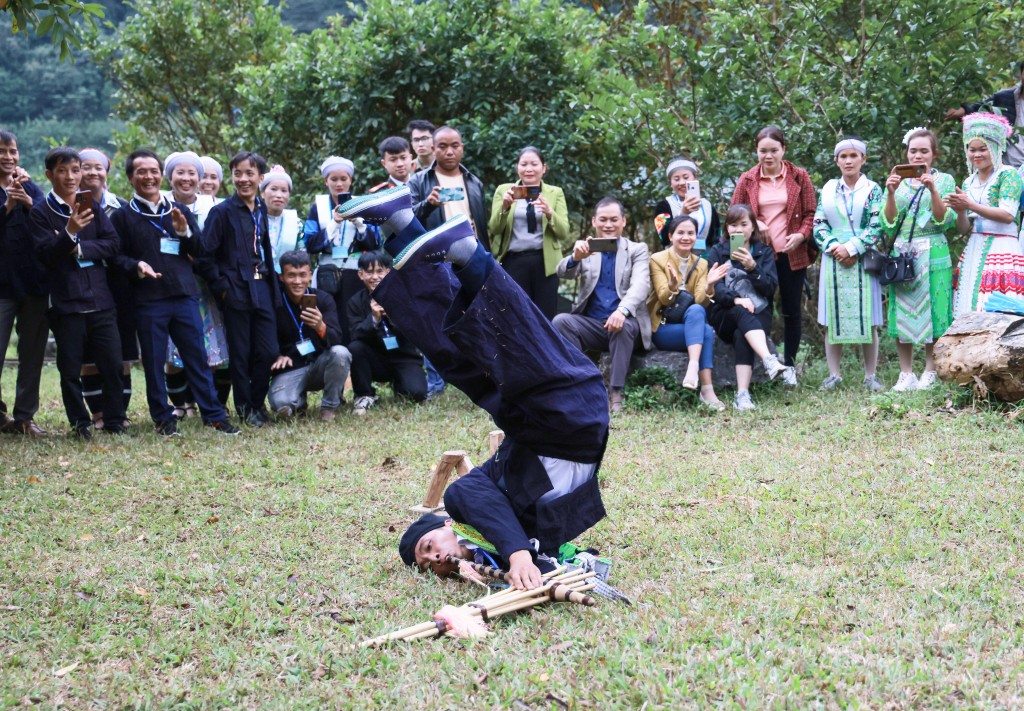 Traditional Arts Through Dance
Traditional Arts Through Dance
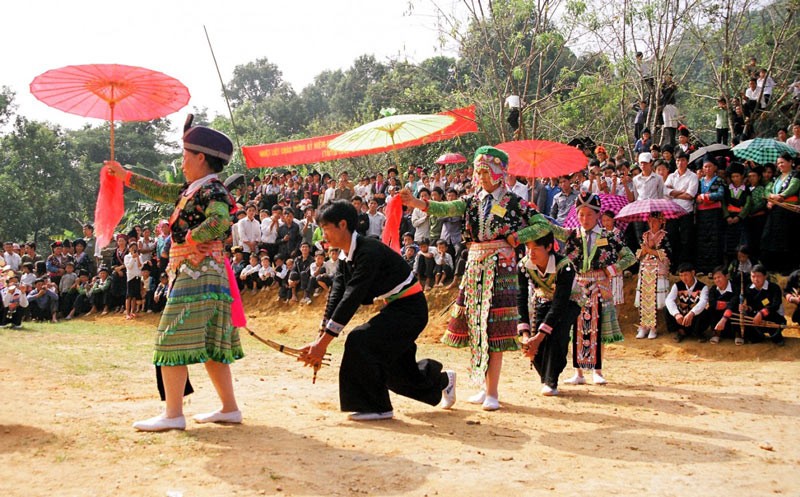 Traditional Arts Through Dance
Traditional Arts Through Dance
4.4. What Traditional Dishes Can Tourists Enjoy?
The Hmong cuisine is a must-try for tourists during the New Year celebrations. Traditional dishes offer a rustic and authentic taste of the northwest mountains:
- Pork Grilled Over Charcoal: Whole pigs are grilled until the skin is crispy and golden, with the meat remaining tender and juicy. Enjoyed with fragrant apple wine.
- Bánh Dày (Glutinous Rice Cake): A symbolic dish made from pounded glutinous rice, representing unity and strength. Paired with sesame or boiled pork.
- Corn Wine: A traditional drink made from locally grown corn and natural yeast, featuring a rich aroma and a smooth, slightly sweet taste. Complements dishes like Thang Co or grilled pork.
- Thang Co: A flavorful stew made with horse meat, organs, and regional spices, slow-cooked to perfection. Best enjoyed with corn wine at festivals.
5. Essential Tips for Experiencing Hmong New Year Celebrations
To ensure a respectful and enjoyable experience during the Hmong New Year, consider these tips. SIXT.VN can provide additional guidance and support to help you navigate the cultural nuances.
5.1. How to Dress Appropriately?
Wear modest clothing, such as long sleeves and pants, especially when visiting homes or participating in rituals. This shows respect for the local customs and traditions.
5.2. What Basic Greetings Should You Learn?
Learning a few basic Hmong greetings can enhance your interaction with the community. Simple phrases like “Nyob Zoo” (Hello) or “Ua Tsaug” (Thank you) can create meaningful connections.
5.3. What is the Proper Photography Etiquette?
Always ask for permission before taking photos, especially during rituals or family gatherings. Respecting people’s privacy and cultural sensitivities is crucial.
5.4. How to Participate Respectfully in Rituals and Games?
Join rituals like ancestral worship with humility and play traditional games such as Pao throwing thoughtfully. Showing genuine interest and respect will be appreciated.
5.5. How to Enjoy Meals Graciously?
When offered dishes like Thang Co or Banh Day, accept them warmly as a gesture of respect and hospitality. Enjoy the flavors and appreciate the cultural significance of the food.
6. Why Visit Northern Vietnam and Northern Laos for Hmong New Year?
Visiting Northern Vietnam and Northern Laos during the Hmong New Year period offers a unique and unforgettable experience. SIXT.VN can help you plan a trip that combines cultural immersion with breathtaking scenery.
6.1. What Makes This Experience Worthwhile?
Exploring the fascinating culture of the Hmong people, enjoying the breathtaking spring scenery, and immersing yourself in a unique and captivating culture will make your trip truly unforgettable. According to a 2024 report by the Tourism Authority of Thailand, cultural immersion experiences are highly valued by tourists. Traveling with a local guide or a reputable travel agency like SIXT.VN can enhance your understanding and appreciation of the local culture.
6.2. How Can SIXT.VN Enhance Your Travel Experience?
SIXT.VN offers a range of services to make your trip seamless and enjoyable:
- Tailored Itineraries: Customized travel plans to suit your interests and schedule.
- Reliable Transportation: Safe and comfortable transportation options, including airport transfers and local transport.
- Comfortable Accommodations: Assistance with booking hotels that meet your budget and preferences.
- Expert Guides: Knowledgeable local guides who can provide insights into the culture and traditions of the Hmong people.
With SIXT.VN, you can experience the Hmong New Year with ease and confidence, knowing that all your travel needs are taken care of.
7. Frequently Asked Questions (FAQs) About Hmong New Year
Here are some frequently asked questions to help you better understand the Hmong New Year and plan your visit.
7.1. What is the Significance of Noj Peb Caug?
Noj Peb Caug marks the end of the harvest season and the beginning of a new agricultural cycle. It is a time for rest, gratitude, and ancestral worship.
7.2. When Does Hmong New Year Typically Occur?
It usually takes place in November or December, before the Lunar New Year.
7.3. Where is Hmong New Year Celebrated?
The main celebrations are held in the mountainous regions of Northern Vietnam and Laos.
7.4. What Should I Wear to a Hmong New Year Celebration?
Modest clothing, such as long sleeves and pants, is recommended to show respect for local customs.
7.5. Can Tourists Participate in the Celebrations?
Yes, tourists are generally welcomed to join in the celebrations.
7.6. What are Some Traditional Hmong Dishes to Try?
Must-try dishes include Pork Grilled Over Charcoal, Bánh Dày, Corn Wine, and Thang Co.
7.7. How Can I Show Respect During the Celebrations?
Ask for permission before taking photos, participate respectfully in rituals, and accept food offerings graciously.
7.8. What is the Meaning of Pao Throwing?
Pao throwing is a symbolic game representing yin-yang harmony, often played by young people seeking love.
7.9. How Can SIXT.VN Help Me Plan My Trip to Experience Hmong New Year?
SIXT.VN offers tailored itineraries, reliable transportation, comfortable accommodations, and expert guides to enhance your travel experience.
7.10. Is It Necessary to Hire a Local Guide?
Hiring a local guide can greatly enhance your understanding and appreciation of the culture and traditions.
8. Call to Action: Experience the Magic of Hmong New Year with SIXT.VN
Are you ready to embark on an unforgettable cultural journey? Discover the enchanting world of the Hmong people during their New Year celebrations with SIXT.VN. Let us take care of all your travel needs, from transportation and accommodations to expert local guides. Contact SIXT.VN today to plan your dream trip and immerse yourself in the vibrant traditions of Northern Vietnam and Laos.
- Address: 260 Cau Giay, Hanoi, Vietnam
- Hotline/Whatsapp: +84 986 244 358
- Website: SIXT.VN
Book your Hmong New Year experience with SIXT.VN and create memories that will last a lifetime
Explore our comprehensive services:
- Airport Transfers: Start your journey stress-free with our reliable airport transfer services.
- Hotel Bookings: Find the perfect accommodations to suit your style and budget.
- Tour Packages: Discover the best of Hanoi with our expertly crafted tour packages.
Don’t miss out on this incredible opportunity to experience the rich culture and breathtaking beauty of Vietnam with SIXT.VN. Contact us now and let us help you plan your adventure!



